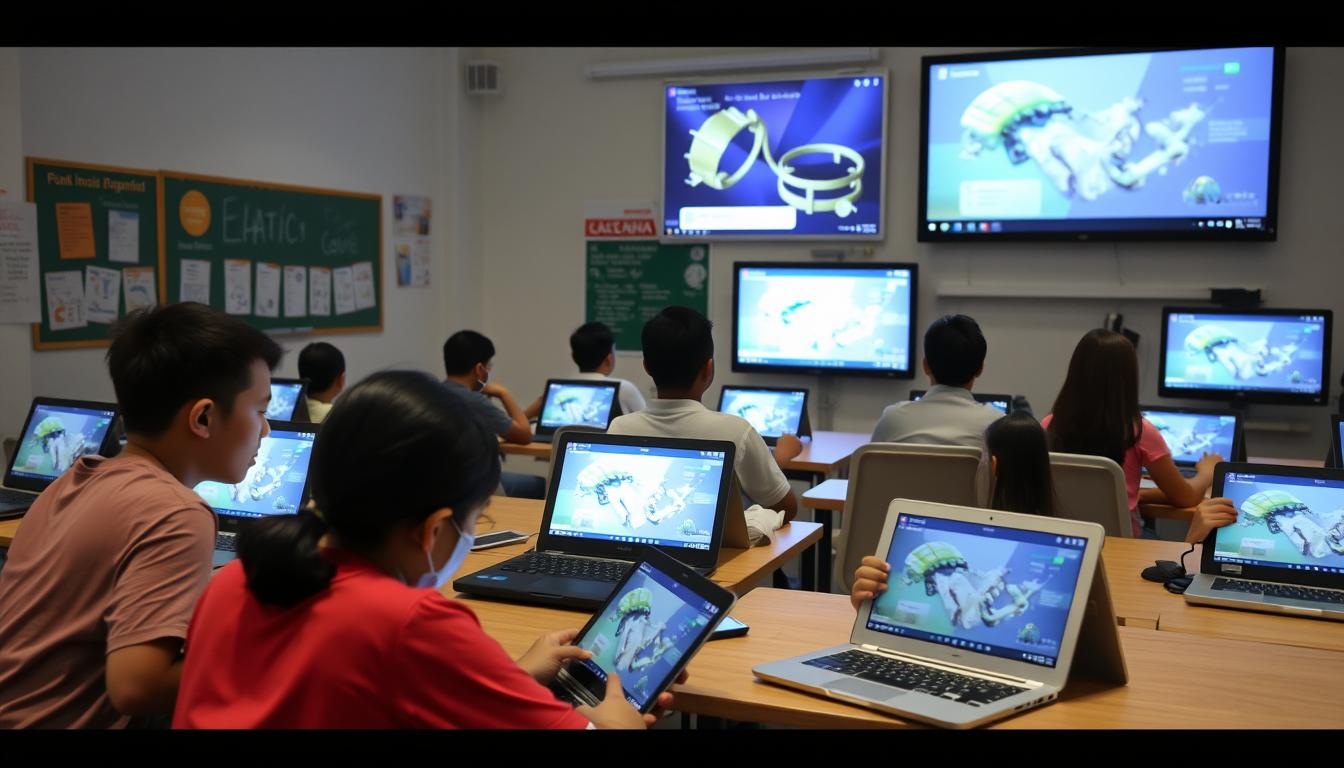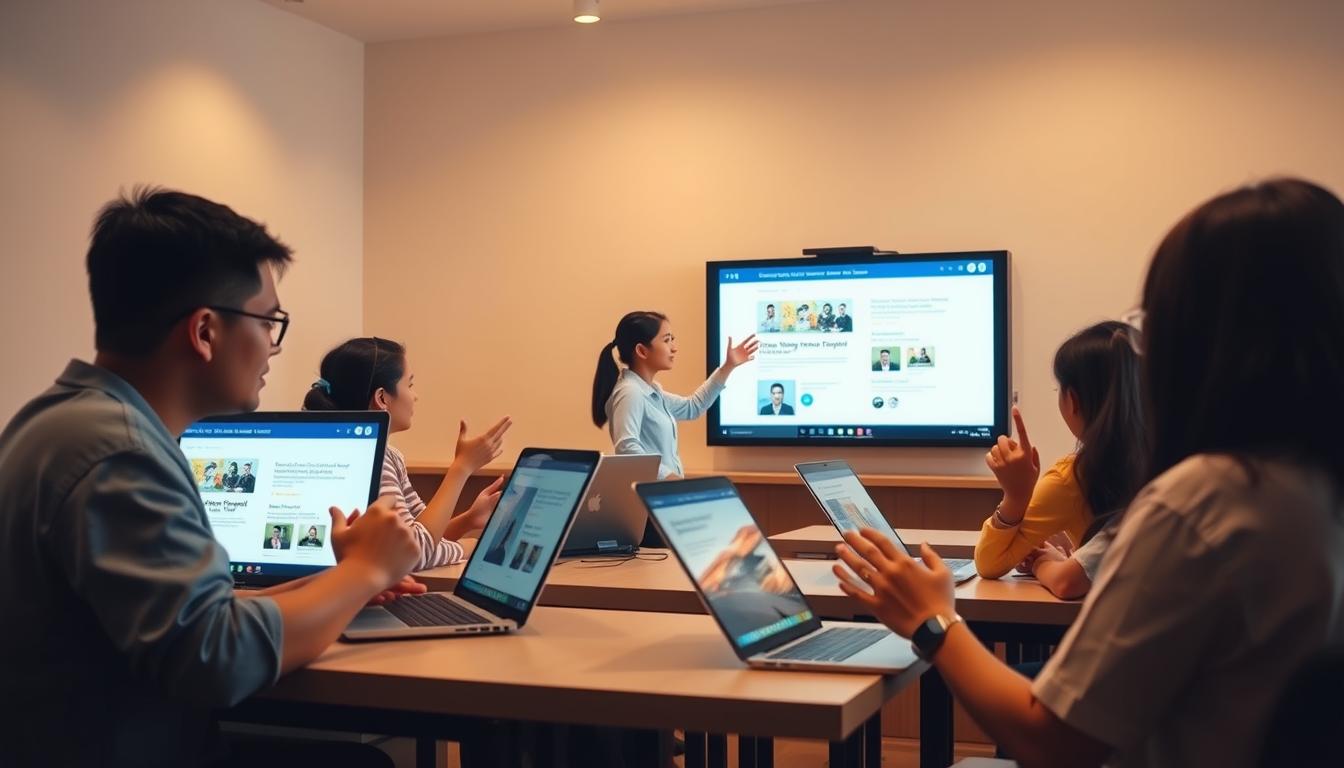Ever thought about how interactive tutorials change the way we learn? In today’s fast world, making learning better is key, more so for small businesses in the Philippines. These tutorials do more than just teach; they make learning fun and keep it going.
By adding things like group talks and different kinds of media, companies can really step up their training game. This leads to better work and new ideas for small businesses.
Key Takeaways
- Interactive tutorials enhance employee engagement and learning retention.
- Effective training strategies consider diverse learning styles to accommodate all employees.
- Peer discussions in tutorials promote collaborative learning and problem-solving.
- Utilizing multimedia elements can make training more engaging and informative.
- Implementing interactive tutorials supports a culture of ongoing learning and adaptability.
The Importance of Interactive Tutorials in Education
Interactive tutorials are key to better learning. They make studying more fun and engaging. This leads to students learning more and staying interested longer.
Enhancing Engagement and Retention
Interactive tutorials really help students stay focused. They learn better and remember more. Activities like group talks and hands-on projects keep things exciting.
These methods help students keep what they learn. It’s a great way to make sure they understand and remember the material.
Addressing Diverse Learning Styles
Interactive tutorials also meet different learning needs. They use pictures, sounds, and hands-on activities. This way, everyone can learn in a way that feels right for them.
This approach makes learning a positive experience for all. It’s great for small businesses in the Philippines to use these methods. It helps create a culture of ongoing learning.
| Learning Style | Preferred Interactive Methods |
|---|---|
| Visual | Infographics, videos, and diagrams |
| Auditory | Podcasts, discussions, and audiobooks |
| Kinesthetic | Hands-on activities and simulations |
| Reading/Writing | Interactive texts and quizzes |
Understanding the Components of Effective Tutorials
To make tutorials effective, we need to know what works. Setting clear goals helps learners know what they aim to achieve. This clarity also helps measure how well they did after finishing.
Clear Learning Goals and Objectives
Having clear goals gives learners direction. Without them, they might lose interest. Clear objectives guide the learning and help track progress.
This approach boosts motivation and personal responsibility. It makes the learning journey more meaningful.
Varied Formats for Different Learning Needs
Using different formats in tutorials keeps learners engaged. This includes videos, quizzes, group talks, and hands-on activities. It meets various learning styles and makes learning more enjoyable.
For small businesses in the Philippines, offering diverse formats is key. It helps create training that everyone can benefit from.
Interactive Teaching Strategies to Consider
Looking into effective teaching strategies can really improve the classroom. Using peer collaboration and technology can make learning fun and supportive. These methods help students get involved and understand the material better.
Peer-to-Peer Collaboration Techniques
Peer collaboration can change how we learn. Activities like group talks, peer reviews, and brainstorming help students share knowledge. These activities boost critical thinking and problem-solving skills.
They let students see different views and ways of solving problems. This makes learning more engaging and effective.
Utilizing Technology for Enhanced Interaction
Technology is key in making learning exciting. Tools like video chats and collaborative software help students work together. They also make learning easier to access.
Interactive features allow for quick feedback and communication. This makes the learning experience richer for everyone involved.
Benefits of Using Interactive Tutorials for Training & Adoption
Interactive tutorials offer many benefits for Training & Adoption. They boost employee engagement and help keep knowledge fresh. By using these tutorials, companies create a fun learning space. This space encourages employees to dive into their learning journey.
This active learning not only helps employees grow but also improves the company’s performance.
Fostering a Culture of Engagement
Creating a culture of engagement starts with the right training tools. Interactive tutorials make learning fun and engaging. This makes employees more eager to join in, ask questions, and share their thoughts.
When employees are involved, they communicate better, work together well, and take their roles seriously. This helps them meet the company’s goals more effectively.
Improving Knowledge Retention and Application
Interactive tutorials do more than just teach. They help keep knowledge alive by adding practical exercises and real-world examples. When employees actively learn, they remember more. This makes it easier to use what they’ve learned every day.
This leads to better work and a team that keeps getting better. It’s a win-win for everyone.
| Benefits | Impact on Employees | Impact on Organization |
|---|---|---|
| Enhanced Employee Engagement | Increased participation in learning | Stronger alignment with company objectives |
| Improved Knowledge Retention | Ability to recall and apply knowledge effectively | Higher productivity and reduced errors |
| Culture of Continuous Learning | Willingness to take on new challenges | Greater innovation and competitive advantage |
Best Practices for Designing Interactive Tutorials
Creating effective interactive tutorials needs careful thought. It’s important to have a clear, step-by-step plan. This makes it easy for users to follow along and learn at their own pace.
Step-by-Step Planning and Organization
A well-structured plan is key for good educational planning. Setting clear goals and organizing content well helps make tutorials that really connect with learners. A logical order helps learners remember more and follow along easily. Here are some tips to help:
- Define clear learning outcomes.
- Break down complex information into manageable steps.
- Utilize checklists to keep users on track.
Incorporating Multimedia Elements
Adding multimedia like videos, animations, and infographics makes tutorials more engaging. These elements help learners understand better and stay interested. For example, multimedia elements cater to different learning styles and make information clearer in today’s fast-paced world. Here are some formats to consider:
| Multimedia Element | Purpose | Benefits |
|---|---|---|
| Videos | Demonstrate processes or concepts | Increases engagement, allows for visual learning |
| Animations | Simplify complex ideas | Aids in understanding, captures attention |
| Infographics | Summarize key points | Facilitates quick comprehension, promotes retention |
Using these best practices can greatly improve tutorial experiences. By organizing steps clearly and adding multimedia, tutorials can reach and engage more people. This makes learning more effective and enjoyable for everyone.
Real-Life Examples from Philippine Companies
Many Philippine companies are leading the way with new training methods. Local SMEs are using interactive tutorials to boost employee skills and engagement. These stories show how practical learning can create a culture of ongoing growth.
Success Stories from Local SMEs
A famous food processing company started an online training platform. It covered food safety, production, and customer service. Employees felt more confident in their jobs, proving interactive tutorials can change the workplace.
A local retail business also made a big impact with gamification in training. They made tutorials fun with game-like features. This approach cut down onboarding time and helped new employees remember more.
Lessons Learned and Innovations
Philippine companies have learned a lot from their experiences. They found that making tutorials fit specific employee needs boosts engagement. They also learned to ask for feedback to make tutorials better and more effective.
Staying innovative is crucial. For example, using virtual reality in training is becoming popular. It offers deep, engaging experiences that improve learning. These stories show a dedication to evolving training methods, preparing employees for the future.
Measuring the Effectiveness of Interactive Tutorials
It’s key to measure how well interactive tutorials work. By setting Key Performance Indicators (KPIs), we can see if they meet their goals. This helps small and medium-sized enterprises (SMEs) in the Philippines improve their learning experiences.
Setting Key Performance Indicators (KPIs)
Choosing the right KPIs is crucial. They should be things we can measure that match what we want to achieve. Some common KPIs include:
- Completion Rates: How many people finish the tutorial.
- Time Spent: How long people spend on the tutorial.
- Assessment Scores: How well people do on quizzes or tests after the tutorial.
By picking KPIs that fit the tutorial, we can really check if it’s working. This makes sure it meets the needs of both the participants and the organization.
Gathering Feedback from Participants
Getting feedback from participants is also very important. It helps us see how good the tutorials are and what can be better. We can use different ways to get this feedback, like:
- Surveys: Asking questions to get numbers about the tutorial.
- Interviews: Talking one-on-one to get deeper thoughts.
- Focus Groups: Talking in small groups to get feedback on different parts of the tutorial.
Using these methods helps us improve and makes participants feel more involved. It also makes sure the tutorials keep getting better for everyone who uses them in the future.
Challenges in Implementing Interactive Tutorials
Small and medium enterprises face many challenges when using interactive tutorials. These include dealing with technology issues and getting employees to accept change. Knowing these problems helps in finding ways to make the transition smoother.
Addressing Technological Limitations
Many companies struggle with technology when they start using interactive tutorials. Old systems might not work well with new features. Also, not enough training on new tech can confuse workers.
Getting the right software is crucial. It helps make sure the technology supports interactive learning. This way, employees get a better learning experience.
Overcoming Resistance to Change
Change can be hard for many employees. They might not want to try new ways of learning, like interactive tutorials. To help, companies need to create a culture that welcomes change.
They should explain why interactive tutorials are good and offer support during the change. Showing the benefits can help employees see the value in new learning methods.
Conclusion
Creating effective tutorials is key for interactive learning in organizations, like those in the Philippines SMEs sector. These tutorials boost employee engagement and improve knowledge retention. They are vital for workforce development.
Interactive tutorials play a big role in training and motivating employees. As businesses in the Philippines grow, they need good training programs more than ever. Using interactive learning helps build a skilled workforce. For more on training programs, check out this resource on effective training strategies.
For SMEs to stay ahead, they must use new learning methods. Interactive tutorials empower employees and encourage ongoing improvement. This focus on effective tutorials helps organizations succeed in a competitive market.




